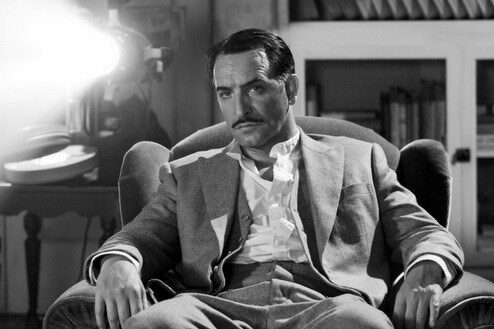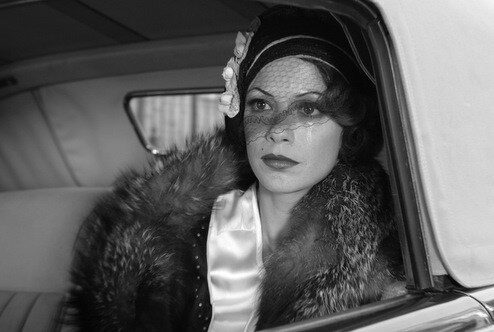The Artist: Interview with Mark Bridges | Clothes on Film
Near silent and shot entirely in black and white, The Artist is a captivating and irresistibly romantic vision of old Hollywood. With international and hopefully Oscar success on the horizon, we talk exclusively to the film’s supremely talented costume designer, Mark Bridges.
Seemingly specialising, though perhaps not intentionally, in bringing to life period stories that are culturally defined by their era (Boogie Nights, There Will Be Blood), Bridges has again expertly recreated another, almost mythical bygone world. Here he explains to Clothes on Film his thought process behind costume design in The Artist, his passion for the silent era and how he managed to get every outfit ready to shoot in just eight weeks.
 Jean Dujardin as silent movie star, George Valentin and Bérénice Bejo as up and coming actress, Peppy Miller. George is a combination of ‘the great lover’ John Gilbert and Douglas Fairbanks, while Peppy channels Clara Bow and a young John Crawford.
Jean Dujardin as silent movie star, George Valentin and Bérénice Bejo as up and coming actress, Peppy Miller. George is a combination of ‘the great lover’ John Gilbert and Douglas Fairbanks, while Peppy channels Clara Bow and a young John Crawford.Clothes on Film, Chris: How did you go about researching the period?
Mark Bridges: First I did a research book for Michel (Hazanavicius, director) that illustrated the script scene by scene, just using images that I found that evoked certain moments in the film. Then I watched as many silent films that I could. I wanted to see how clothes were worn, the hemline lengths and accessories and observe the subtle changes in fashion from year to year. Michel loved the films Sunrise, and City Girl and The Crowd for their emotional tone, but for me I used the films It and Our Dancing Daughters for Peppy Miller (Bérénice Bejo) research. A particular favourite of mine for everything Hollywood is King Vidor’s Show People from 1928, which was shot on the MGM lot as their locations. I used the look of George entering the studio from the image of John Gilbert arriving on the lot in Show People.
CoF: Isn’t it true that a lot of silent movie stars wore their own clothes as costumes..?
MB: I think in the early days of film it was customary for actors to wear their own clothes, and certainly that was true for men’s contemporary clothes for many years into the talkies.
 George with his overshadowed co-star, Constance (Missi Pyle). That The Artist was shot in LA was of great help to Mark Bridges, as the city is full of tailors, dressmakers, shoemakers, etc, all accustomed to working to rigid filmmaking schedules.
George with his overshadowed co-star, Constance (Missi Pyle). That The Artist was shot in LA was of great help to Mark Bridges, as the city is full of tailors, dressmakers, shoemakers, etc, all accustomed to working to rigid filmmaking schedules.CoF: Presumably using actual 1920s dresses was impossible due to their fragility now?
MB: Some of the dresses used in the film were real 1920s dresses, but most had some sign of age to them or a repair so they weren’t suitable to use on Peppy. I found 1920s dresses that were great shape but very fragile and had them copied in new silks for Peppy. Even before her stardom I made Peppy’s dresses in silk crepe de chine, a kind of simple, typical fabric used at the time. Many dresses in the Sears catalogue in 1927 were very inexpensive frocks made of silk crepe. The dresses that did hold up for me to use on day players and background were usually made of cotton or light wool, but being over eighty years old, most of them had a bit of damage somewhere.
CoF: Peppy Miller’s dress for her audition at the film studio was particularly short. Did you source any twenties style dresses from later eras?
MB: Her audition dress was copied from a lovely little 1920s dress that had shoulders so small it was difficult to get on and off. The length of the original was above her knee, which I liked for this bold young woman. As far as sourcing from other periods I don’t think it works because there is always the sensibility of the decade that reinterpreted the design. If anything, with our version of the twenties, changes were made to fit better and be more flattering to Bérénice to the modern eye. I always start with the actual period dress.
 Peppy with ‘The Butler’ (Malcolm McDowell) ready to audition. Most of the dresses Bérénice wore in the film were actually black and white, dark blue or aqua. “Non colours” as Mark Bridges refers to them.
Peppy with ‘The Butler’ (Malcolm McDowell) ready to audition. Most of the dresses Bérénice wore in the film were actually black and white, dark blue or aqua. “Non colours” as Mark Bridges refers to them.CoF: I understand you only had eight weeks to prep. With such a detailed period piece, how did you did you cope?
MB: I rarely do a project that has more prep time than eight weeks so it always comes down to good planning, an agreed idea with the director and production designer and a bit of good luck. The fact that my prep and shoot were in Los Angeles helped because we are set up there with amazing costume rental shops, tailors and dressmakers, milliners and shoemakers all accustomed to working on extremely tight movie making schedules. As I pull costumes certain clothes “speak to me” what they might be used for and when I do a principal’s fitting I try to do their fitting in script order, following the arc of the character.
At some point in prep I switch into “priority mode” and work in order of shooting and continue prepping and grabbing quick fittings as we shoot. In the case of George it was a matter of seeing what existing suits worked with minor alteration and what garments needed to be made. Refining the costume details happen every day we shoot and each time we “establish” a costume on film.
CoF: How did Bérénice Bejo and Jean Dujardin respond to wearing the costumes?
MB: I found that the actors respond best to a costume choice when there is a convergence of them looking good and feeling like someone else. Once we get on a thread of the character it becomes easier to discern what would be “George” or “Peppy”. They could say right away what they felt right in and I would agree or point out any problems I thought there were with that choice. It is always a great back and forth when discovering and creating a character. The casting of those two actors was perfect and has been mentioned in several reviews.
 Jean Dujardin’s costumes were a mixture of made to measure and existing suits altered to fit the actor. Note the fit of his trousers; very high waisted, they are never too long and with almost no break.
Jean Dujardin’s costumes were a mixture of made to measure and existing suits altered to fit the actor. Note the fit of his trousers; very high waisted, they are never too long and with almost no break.CoF: Apparently Bérénice is wearing her costumes on the red carpet; she is keen to show off colours that we obviously do not see in the film. You must be flattered?
MB: Peppy’s dresses are black and white or navy blue or pale aqua. Non-colours really. While we were shooting there was always the chance it would be seen in some film markets in colour, so things aren’t that crazy or colourful. I am flattered that she loves her costumes so much, but she is dazzling in any period.
CoF: It is interesting how you can read Peppy’s life through her clothes. Was this your intention, to tell her story through costume?
MB: It is always my intention when designing costumes to quietly illustrate what is happening in the story through the character of the clothes. Thank you for noticing.
 Peppy wrapped in a fur stole. Later in the story she wears an actual 1920s coat trimmed in monkey fur. Typically, fur comes to signify wealth and success; for many people the unobtainable in life.
Peppy wrapped in a fur stole. Later in the story she wears an actual 1920s coat trimmed in monkey fur. Typically, fur comes to signify wealth and success; for many people the unobtainable in life.CoF: Is that by any chance a gorilla fur coat that Peppy is wearing later in the story?
MB: Yes it was a 1920s coat trimmed in monkey fur found at Palace Costume Company in Hollywood. Michel affectionately referred to it as “King Kong”.
CoF: The 1920s are currently very fashionable. Were you aware of contemporary trends when designing the costumes?
MB: I was not aware of contemporary trends when designing The Artist. My only focus was serving the piece the best I could with the resources available. Just a lucky break I guess that there is a renewed interest in the 1920s just when we open the film!
With thanks to Mark Bridges.
© 2011 – 2014, Lord Christopher Laverty.